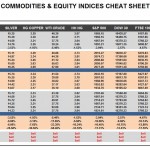Soft Futures market outlook

Wheat futures once again started firm, but whether they will end that way…
There may be some cause to hope that the trend which set in on Tuesday, of strong starts followed by weak closes, may come to an end, if only from the calendar.
This weekend is a long one in the US, with Monday bringing Memorial Day, meaning that – with the risk of a change in the forecasts of rain for the southern Plains and Russia which have been depressing prices – investors may be tempted to take profits on short positions in wheat.
Benson Quinn Commodities noted that three-day weekends often prove “trend changers”, although the difference may only be evident after the event, with the broker citing, in soybeans, “the post Good Friday/Easter holiday sell off following the Thursday new contract high in the July at $15.21 a bushel”.
Too much, too late?
Furthermore, chart-wise, Chicago’s July contract, having fallen through a series of technical points with ease, is showing some reluctance over falling through its 200-day moving average, at $6.58 a bushel.
The contract in the last session fell through it only to reverse above, showing mettle which has been absent for most of the last two weeks.
And there are questions remaining too about how much good the southern Plains rain will actually do to crops that are quite far along.
Could some crops actually be damaged by rains that look like coming in at high rates, and potentially in the form of hail too, with tornado risks on top?
“Forecasts are calling for 1-3 inches over the next five days,” CHS Hedging said
China recovery
That said, the worldwide trend on wheat fundamentals has taken a more reassuring turn, from a supply perspective, with Argentine wheat sowing expectations growing, with the farm ministry pegging area at 4.5m hectares, above a forecast from the Buenos Aires grains exchange.
In China, there are reports of a strong recovery in the harvest in Henan province, responsible for about one-quarter of domestic output, where higher sowings and better weather are expected by news agency Xinhua to take production to a “new high”.
Still, for now, Chicago soft red winter wheat, the world benchmark, was up 0.5% at $6.62 ¾ a bushel as of 09:40 UK time (03:40 Chicago time).
Kansas City hard red winter wheat, the type hurt by US southern Plains drought, added 0.2% to $7.53 ½ a bushel.
‘Buying mood’
For soybeans, the news from China has been more supportive, with fresh import orders, both confirmed and rumoured, from Brazil and the US reassuring investors who had been worried over falling demand, a knock-on effect from sagging livestock markets.
“China did buy 120,000 tonnes of soybeans on Thursday, fuelling rumours that they are once again in a buying mood,” CHS Hedging said.
“One Chinese processor bought 600,000 tonnes of soybeans for 2014-15 last week for shipment to begin after September 1.”
Sterling Smith at Citigroup said: “The market has clearly lost any fears about Chinese demand either current or going forward.”
‘Profit-taking should be expected’
But will that change today?
“There is holiday looming so seeing some profit-taking should be expected,” Mr Smith added.
Furthermore, the revival in prices of soybeans in China itself faded, with the January contract on the Dalian dropping 0.7% to 4,584 yuan a tonne.
Besides, not all observers are quite so convinced over another key part of the story behind the soybean rally, of tight US supplies, and the idea that more rationing is needed to quell demand, and/or inspire further imports from Brazil.
July vs November
Decent US old crop export sales data on Thursday “were the first signs of bullish news to help explain the last three days of market action”, one US broker said.
However, on Thursday, “the July futures actually lost ground to the November contract which is counterintuitive. If the market was strong due to old crop tightness, the rally would be led by the front month contract, not the new crop.
“We are still nearly 30 cents a bushel below that spread high reached back in April, which means new crop soybeans have guided this rally.”
In fact the new crop November contract stood up 0.3% at $12.74 ¼ a bushel, lagging the July contract, which added 0.4% to $15.24 ½ a bushel.
‘May be providing a bid’
The November contract also failed to gain any more ground against December wheat, with the much-watched ratio between the two lots steady at an elevated 2.68:1.
December corn was also up 0.4%, at $4.75 ¼ a bushel, although it is not clear how much oomph there is behind the contract’s rise, with US spring sowings seen progressing quickly, after all.
“There are few signs that the speculative trade is committed to adding length,” Brian Henry at Benson Quinn Commodities said.
“However, the soybean to corn ratio of 2.7:1 is continues to draw the speculative interest and may be providing a bid in the December corn contract.”
The July contract was doing a bit better, adding 0.5% to $4.79 a bushel, supported by a better fundamental story, with US export sales running well ahead of the pace needed to meet full-season expectations.
The weekly sale of 509,700 tonnes announced yesterday compares with a weekly pace of 226,000 tonnes or so actually required.
‘Very hard to be bullish’
Among soft commodities, the coup in Thailand, the second-largest sugar exporting country, continued to offer no support at all to prices of the sweetener.
Raw sugar for July fell 0.5% to 17.29 cents a pound in New York, on course for a seventh successive negative close.
“Chatting around the market it seems domestic prices in some important destinations are falling and so there seems to be only passive buying rather than aggressive buying,” Tom Kujawa at Sucden Financial said.
“It’s very hard to be bullish at the moment. There are credible upside risks but they investment community has already invested heavily on this story, and look now a little exposed.”
But New York cotton perked up, adding 0.2% to 87.99 cents a pound for July, despite the southern Plains rain, which is improving planting prospects.
Still, share markets are strong, with world shares around their highest level in six years, according to the FTSE All World index, and cotton, as an industrial commodity, tends to be more sensitive to broader market forces than food ags.
Source: agrimoney





























